Driving an unremarkable car is a dream that many of us are now living: if I want to drive an unmodified Honda Civic (unless you count a few dents as modifications) then I can go outside now and drive it wherever I like (but probably to either Waitrose or the tip).
Often in driving or racing games, the slow car is something to be endured until you play for long enough to unlock the faster ones. At other times, though, you’re given the full selection from the start, which begs the question: what’s the point of including them at all?
Whether it was the nerdy childhood appeal of pretending to race a car that you’d actually seen in real life, the potential for comedy value (intentional or otherwise), or simply the fact that they were more fun to drive, gaming’s underpowered cars have provided plenty of fun over the years.
So, why not join us as we take a look back through gaming history to evaluate the merits of the less exciting end of driving games’ vehicle selection screens?
Muscle Cars – Test Drive II: The Duel (Accolade, 1989)
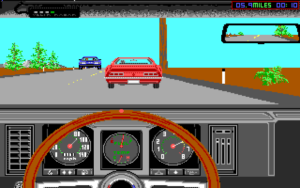 As the title suggests, the core game of Test Drive II was about two cars – THE FASTEST CARS IN THE WORLD (in 1989) – namely, the Ferrari F40 and Porsche 959.
As the title suggests, the core game of Test Drive II was about two cars – THE FASTEST CARS IN THE WORLD (in 1989) – namely, the Ferrari F40 and Porsche 959.
You’d think that didn’t really leave Accolade anywhere to go, but, showing admirable devotion to the slower car (and making money), they released two vehicle add-on packs: The Supercars (a selection of modern sports cars, all slower than the big two, and a line-up that bears a suspicious resemblance to that of the first game) and The Muscle Cars (5 big gas guzzlers from the 60s).
On the one hand, TDII is a better game than its predecessor, which suffered from excessively sluggish handling and repetitive cliffside scenery, and provides a better basis for (ahem) test driving the cars. On the other, the slower vehicles, particularly the 60s Muscle Cars, seem rather bland when compared with those on offer in the main game; subtleties in handling are largely absent; and you’re much more likely to be caught by the police.
There’s a nice selection of dashboards, for those fetishists out there, but otherwise the original duel is where the action is.
Lancia Delta Integrale – 4D Sports: Driving/Stunts (Brøderbund, 1990)
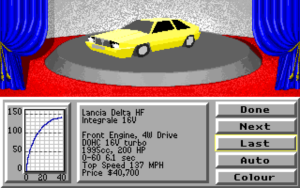 Test Drive developers Distinctive Software went on to make Stunts, a cult favourite in these parts. The track construction kit and wide selection of cars provided endless opportunities for messing about, and setting custom challenges (“here is this absolutely mental track I created, now beat my time with…the Audi Quattro”) back in the day.
Test Drive developers Distinctive Software went on to make Stunts, a cult favourite in these parts. The track construction kit and wide selection of cars provided endless opportunities for messing about, and setting custom challenges (“here is this absolutely mental track I created, now beat my time with…the Audi Quattro”) back in the day.
It wasn’t the slowest car in Stunts (that honour belonged to the Lamborghini LM002) but the aficionado’s slow car of choice was the Lancia Delta Integrale. While the real car was a nippy effort that achieved notable success in the World Rally Championship (and later earned an appearance in Sega Rally) there was something about its depiction in Stunts – it seemed too small, the dashboard was brown, and the default colour was a pale yellow – that made it look like the kind of car your grandparents would drive, lending it significant comedy value. Here’s a clip of it attempting Rik’s patented ‘3 building jump challenge’…
Mythos Pininfarina – Test Drive III: The Passion (Accolade, 1990)
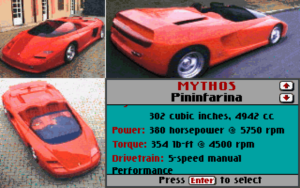 The Test Drive series limped on without Distinctive, and this third effort was certainly ambitious, pushing into full 3D, adding alternative routes and weather effects. Unfortunately, for our purposes, two of the three vehicles were wacky concept cars (the Ferrari Mythos Pininfarina and Chevrolet CERV III) and the third was the FASTEST CAR IN THE WORLD, the Lamborghini Diablo.
The Test Drive series limped on without Distinctive, and this third effort was certainly ambitious, pushing into full 3D, adding alternative routes and weather effects. Unfortunately, for our purposes, two of the three vehicles were wacky concept cars (the Ferrari Mythos Pininfarina and Chevrolet CERV III) and the third was the FASTEST CAR IN THE WORLD, the Lamborghini Diablo.
One of the game’s many flaws was that it was far too fast to actually see what was going on, and so some less ambitiously powered vehicles might have been welcome. Which made the Mythos, the slowest of the three originals, the most sensible option. The Road & Car pack later provided an Acura NSX and Dodge Stealth, and a slightly straighter section of road, to restore some balance.
1957 Ferrari Testarossa – Car and Driver (Electronic Arts, 1992)
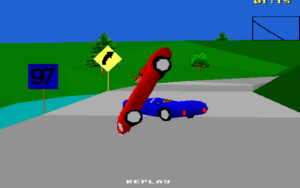 Another example of a slow car being chosen out of expediency, the notoriously tricky Car and Driver gives you a couple of highway routes upon which to enjoy a leisurely drive, but then emphasises the dangers of the road in a brutal manner akin to an episode of Police, Camera, Action!
Another example of a slow car being chosen out of expediency, the notoriously tricky Car and Driver gives you a couple of highway routes upon which to enjoy a leisurely drive, but then emphasises the dangers of the road in a brutal manner akin to an episode of Police, Camera, Action!
Developers Looking Glass went on to make serious flight sims including Flight Unlimited, and though this might look like a Test Drive or Need For Speed game, on anything but the easiest settings you’ll be spinning and rolling your chosen dream car towards certain doom. With that in mind, it’s worth considering the ’57 Testarossa, a far cry from the 80s dream machine of Outrun fame, even if it does mean you’re subjected to a crude potato head representation of your driver in the replays.
Any 1994 Ford – Ford Simulator 5 (The SoftAd Group, 1994)
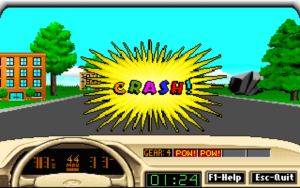 A curious entry in gaming history, the Ford Simulator games were part glossy showroom brochure, part dreadful sub-Test Drive driving game. You’d think you’d be in slow car heaven here, but despite an enterprisingly dull selection of vehicles, not a huge amount of effort was expended in differentiating them out on the road. Dashboard fetishists, in particular, will be disappointed, as will European gamers expecting to see familiar Ford models – where’s the Fiesta? The Granada? The Orion?
A curious entry in gaming history, the Ford Simulator games were part glossy showroom brochure, part dreadful sub-Test Drive driving game. You’d think you’d be in slow car heaven here, but despite an enterprisingly dull selection of vehicles, not a huge amount of effort was expended in differentiating them out on the road. Dashboard fetishists, in particular, will be disappointed, as will European gamers expecting to see familiar Ford models – where’s the Fiesta? The Granada? The Orion?
Mazda RX7 – The Need for Speed (Electronic Arts, 1995)
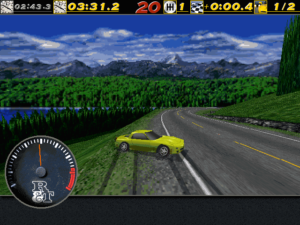 We’ve already written about The Need for Speed‘s Lamborghini Diablo, but a high top speed, combined with the game’s sluggish braking and steering, makes the game’s faster cars less than enjoyable to drive.
We’ve already written about The Need for Speed‘s Lamborghini Diablo, but a high top speed, combined with the game’s sluggish braking and steering, makes the game’s faster cars less than enjoyable to drive.
At the other end of the spectrum is the Mazda RX7, the slowest car in TNFS. Later to become a high end dream machine during the NFS Underground import years, here the RX7 calls to mind a punier model like the MX5 (the kind of car your middle-aged neighbour might have). Even the yellowy green colour is kind of unimpressive. I don’t care if it does have a Wankel Twin Turbo (snigger).
It’s good fun to drive, though, even if it is harder to evade the police or prevent opponents’ superior top end speed besting you. But, on a twistier course like the final section of Alpine road, it should be possible to triumph over even the mighty Diablo, which may well speed past you at the start but is equally likely to plough guilelessly into traffic later on, allowing you to sail past wearing a smug expression.
In Part 2: the late 90s! With more Need for Speed, Midtown Madness and, er, others!



 Posts
Posts
[…] Taking a quick spin with the Lancia Delta in Stunts. For more, see the feature on gaming’s slower cars here: http://www.forceforgood.co.uk/gamings-slower-cars-a-brief-and-selected-history-part-1/ […]
April 28, 2018 @ 11:51 am